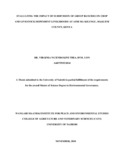| dc.description.abstract | Failure of the ranching system in Kenya has seen a progressive decline in the number of group ranches since 1952 due to subdivision. Ranch subdivision transforms the landscape in terms of human and land use systems. Studies have generally concentrated on its effects on land productivity and biodiversity. However, ranch subdivision effects on the social wellbeing of communities have not been adequately studied, perhaps due to its broad, diverse, and complex nature. Furthermore, studies on the relationship between ranch subdivision and the resultant agricultural productivity are not conclusive. The objectives of this study were; to assess the effect of ranch subdivision on crop and livestock productivity and to assess the prevailing attitudes concerning land tenure and land use systems and the social mind set transformations seen after ranch subdivision. The study was conducted at the recently subdivided ranch, Aimi ma Kilungu (AMK) in 2006, to the former shareholders and their families, who then settled on the resulting 1530 plots. Semi-structured interviews and participant observation were used to collect data on type and quantity of assets, livelihood activities and their returns after subdivision of the ranch. There were 79 respondents randomly selected from among those who had settled in AMK after subdivision. The driving forces for ranch subdivision were; the opportunity to change their fate (about 45%) and economic empowerment (about 44%). Factors such as ownership of land (1%) and the desire for freedom (0.3%) also played a role. The results of the study showed that location of the plot had an influence on the income returns of the household. Households near water (KES 2.5 million/year) and tarmac (KES 1.8 million/year) had higher total income returns (productivity). The results also demonstrated that crop production (KES 34,369/year) had higher returns than all other livelihood activities including livestock keeping (KES 33,684). That is probably why the settlers preferentially allocated more land to crops (average of 4 acres per household) than to other
vi
use of land. However, keeping livestock was very popular as it allowed the residents to have readily disposable assets to meet urgent needs. The study also highlighted challenges faced by the settlers of AMK, coping strategies and the transformations resulting from the subdivision. Some of the challenges included; human-wildlife conflict, lack of livestock feeds and lack of amenities in the area. Positive subsequent developments were observed including water harvesting (38%), storage of fodder (29%) and adoption of zero grazing (3.8%). These transformations in AMK were a form of coping strategies to the challenges encountered on settling in AMK. Conclusively, ranch subdivision was shown to have a significant positive impact on the prevailing attitudes, on land tenure and land use and is a preferred form of development where group ranches fail. | en_US |



